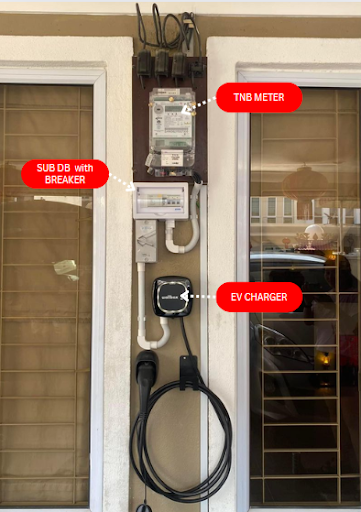Understanding Your Home Wiring System
1. TNB Meter
The journey begins at the TNB meter, which measures the electrical consumption of your home. The meter is connected to the main power supply from the grid and is usually located outside your home or in a designated utility area. From this meter, electrical current flows into your home’s electrical system.
2. Main Distribution Board (DB)
After the TNB meter, the electrical current enters the Main Distribution Board (DB) of your home. This board is the central hub for managing the electrical distribution within your home. It contains several circuit breakers that protect different areas of your home by disconnecting the power in case of faults or overloads.
3. Sub-Distribution Board (Sub DB)
In some homes, especially those with higher electrical demands, a Sub-Distribution Board (sub DB) is installed. This board is connected to the main DB and serves as an intermediary that distributes power to specific circuits or areas, including the one for your EV charger. The sub DB allows for more organized and manageable wiring, helping to keep your home’s electrical system efficient and safe.
4. Wiring to the EV Charger
From the sub DB, dedicated wiring is routed to the location where your EV charger will be installed. This wiring is crucial as it carries the electrical current specifically to the charger. It’s important to use the correct gauge and type of wiring to handle the load required by the EV charger and ensure safety. The wiring setup includes a dedicated breaker in the sub DB for the EV charger, which acts as a safeguard against potential faults.
5. Safety Measures
Incorporating safety measures is essential. For instance, the sub DB should include appropriate protection devices, such as Residual Current Devices (RCDs) or Miniature Circuit Breakers (MCBs), to protect against electrical faults and ensure that the EV charger operates safely. Additionally, using a dedicated breaker for the EV charger ensures that any issues with the charger won’t affect other circuits in your home.

Ensuring Safety in EV Charger Installations: Why Tapping from the TNB Meter Isn’t Recommended
| Safety Concern | It's safer to tap the EV charger from the home’s main breaker rather than directly from the TNB meter. The home breaker provides an additional layer of protection that can prevent the charger from burning if there’s an issue with the breaker’s sensitivity. |
| Danger of Direct Tapping | Tapping directly from the TNB meter is considered dangerous because if there’s a power issue, you would need to remove the cutoff fuse to cut off the supply. If a cable burns, it could lead directly to the meter, which could be hazardous and potentially damage the TNB meter. |
| Risk of Damage | If there’s a current leakage and the EV charger is tapped directly from the TNB meter, it might damage the meter. If tapped from the home’s main breaker, there are two layers of protection—both the main breaker and the sub-distribution board (sub DB)—to prevent damage. |
| Potential Cost | If the TNB meter is damaged due to improper tapping, the compensation to TNB would be high. |
| Phase Considerations | Tapping directly from the TNB meter might be feasible for a single-phase system but is more dangerous for a three-phase system due to the number of cables causing wire bending difficulties. |
Conclusion
In conclusion, while tapping directly from the TNB meter might seem like a viable option for installing an EV charger, the potential risks and costs associated with this approach make it less favorable. Opting to tap from the home’s main breaker provides an added layer of protection, reducing the risk of damage to the TNB meter and ensuring a safer, more reliable installation.
For safe and reliable EV charger installations, contact RExharge as we prioritize safety and reliability above all else. Our team of expert technicians is certified by the Suruhanjaya Tenaga (ST), ensuring that every installation meets the highest standards of safety and efficiency. We carefully assess each situation to avoid impractical and unsafe installation practices, providing you with peace of mind and long-term protection for your home and EV charging system.


